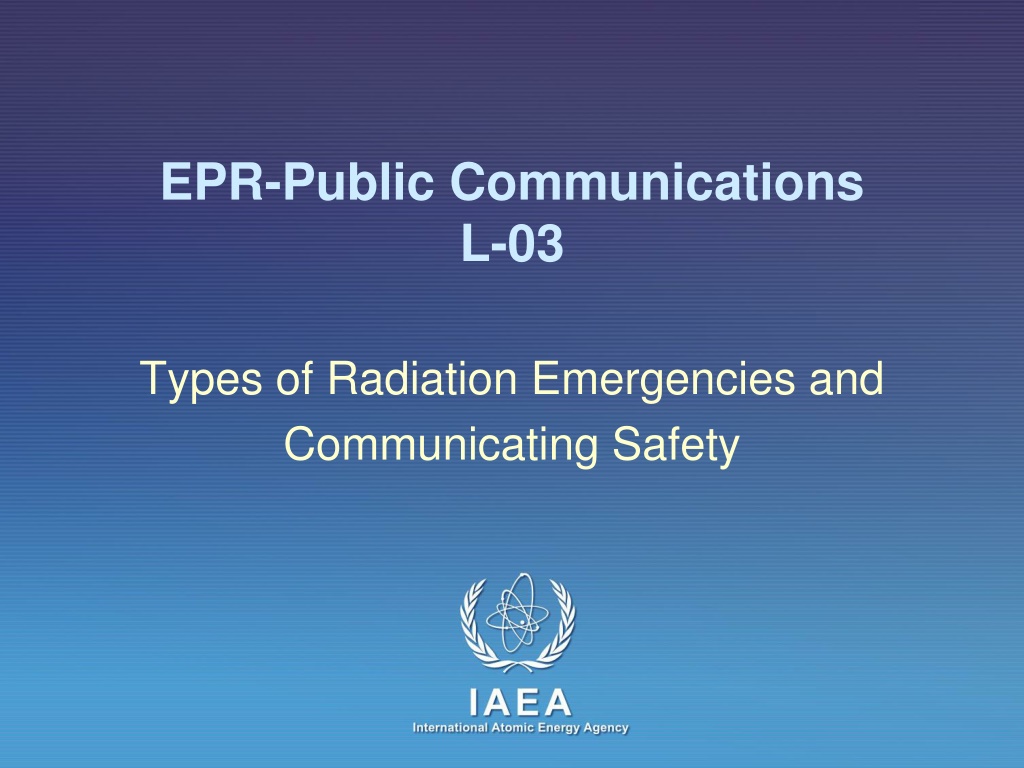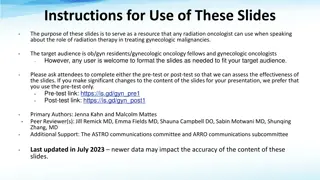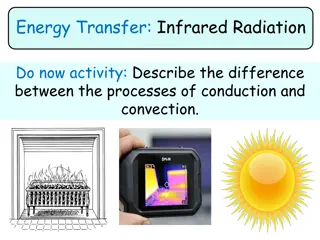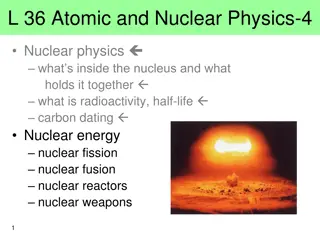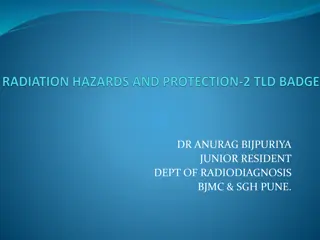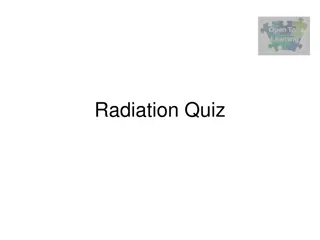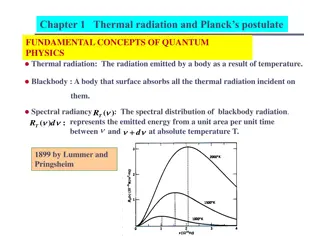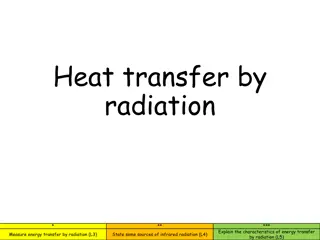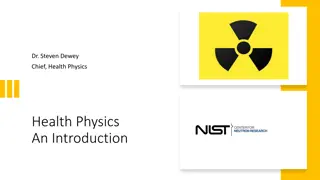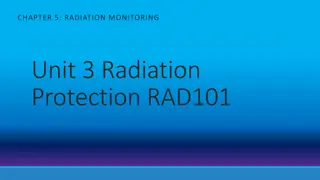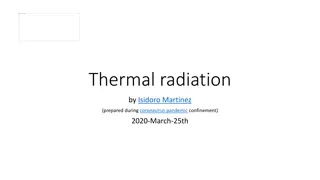Understanding Different Types of Radiation Emergencies
Explore the various types of radiation emergencies such as those from nuclear facilities, medical sources, illicit trafficking, and malicious acts. Learn about threat categories, nuclear emergencies, and radiological emergencies to better understand safety protocols and potential risks associated with each type of emergency.
Download Presentation

Please find below an Image/Link to download the presentation.
The content on the website is provided AS IS for your information and personal use only. It may not be sold, licensed, or shared on other websites without obtaining consent from the author. Download presentation by click this link. If you encounter any issues during the download, it is possible that the publisher has removed the file from their server.
E N D
Presentation Transcript
EPR-Public Communications L-03 Types of Radiation Emergencies and Communicating Safety
Types of radiation emergencies Nuclear facilities; Radiation sources from medical, industrial and research areas; Illicit trafficking; Malicious acts. 2
Threat categories Threat Category Description of where the category applies Facilities, such as nuclear power plants, for which on-site events (including very low probability events) are postulated that could give rise to severe deterministic health effects off the site, or for which such events have occurred in similar facilities. I Facilities, such as some types of research reactors, for which on-site events are postulated that could give rise to doses to people off the site that warrant urgent protective actions in accordance with international standards, or for which such events have occurred in similar facilities. II Facilities, such as industrial irradiation facilities, for which on-site events are postulated that could give rise to doses that warrant or contamination that warrants urgent protective actions on the site, or for which such events have occurred in similar facilities. III Activities that could give rise to a nuclear or radiological emergency that could warrant urgent protective actions in an unforeseeable location. These include non-authorized activities such as activities relating to dangerous sources obtained illicitly. They also include transport and authorized activities involving dangerous mobiles sources such as industrial radiography sources, radiothermal generators or nuclear powered satellites. Threat category IV represents the minimum level of threat, which is assumed to apply for all States and jurisdictions. IV Activities not normally involving sources of ionizing radiation, but which yield products with a significant likelihood of becoming contaminated as a result of events at facilities in threat categories I or II, including such facilities in other States, to levels necessitating prompt restrictions on products in accordance with international standards. V 3
Nuclear emergencies Nuclear emergencies (threat categories I, II or III) may occur at: Large irradiation facilities (e.g. industrial irradiators); Nuclear reactors (research reactors, ship reactors and power reactors); Storage facilities for large quantities of spent fuel or liquid or gaseous radioactive materials; Fuel cycle facilities; Industrial facilities (e.g. facilities for manufacturing radiopharmaceuticals); Research or medical facilities with large fixed sources (e.g. teletherapy sources). 4
Radiological emergencies Radiological emergencies (threat categories IV and V) can occur anywhere and include: Uncontrolled (abandoned, lost, stolen or found) radiological sources; Misuse of industrial and medical radiological sources; Public exposures and contamination from unknown origins; Serious overexposures; Malicious threats or acts; Transport emergencies; 5
Unplanned Releases Unplanned releases as a result of an accident: Organizations using ionizing radiation should: Have response plans for emergencies that could lead to radiation releases; Carry out exercises involving staff and staff of other agencies to test responses; Produce and disseminate messages to the public that are primarily factual and address public demand for authoritative and reliable facts and figures. 6
Lost/ orphan radioactive sources Possibility of coming into contact with radiations sources without realizing it due to lost or orphan radioactive sources; Possibility of large individual exposures and some contamination. 7
Releases from deliberate acts Releases as a result of deliberate acts by individuals or groups: Depends on motives, capabilities and opportunities; Outcomes not necessarily different from unplanned or unintentional releases but the special characteristics of such emergencies need to be carefully considered; Public communications protocols should be agreed with appropriate authorities to ensure protection of public health without compromise to investigation; Carefully brief spokesperson(s). 8
International Nuclear and Radiological Event Scale - INES 9
Classification INES classifies nuclear and radiological accidents and incidents by considering three areas of impact: People and the Environment; Radiological Barriers and Control; Defence-in-Depth 10
Examples 7 Major Accident e.g. Chernobyl (1986) 6 Serious Accident e.g. Kyshtym (1957) 5 Accident With Wider Consequences e.g. Three mile island (1979) 4 Accident With Local Consequences e.g. Tokaimura (1999) 3 Serious Incident e.g. Vandellos (1989) 2 Incident e.g. Cadarache (1993) 1 Anomaly e. g. Industrial radiographer worker overexposure 0 Deviation (No Safety Significance) e. g. false alarm in Kr ko, Slovenia (2008) 11
Communicating safety Communicating safety in emergencies involving small dangerous radioactive sources. Very dangerous source from radiography camera (should never be picked up) Typical radiography camera 12
Communicating safety To protect yourself, if you think an object is a radioactive source: Do not touch or pick it up; Keep away from it 30 meters; Keep other people away from it (cordon it); If you have touched it, been near it or been near someone who may have touched it, keep your hands away from your mouth and wash your hands before you eat, drink or smoke; Immediately notify local police or emergency services. 13
Communicating safety Communicating safety in a large scale emergency: Quickly communicate degree of safety to public near emergency site, including any protective actions; Use prepared statement templates; Anticipate and address media and public inquiries; Use IAEA set of default operation intervention levels (OILs) and plain language templates in case of release of radioactive material. 14
Conclusion PIOs should be aware of the different and potential emergencies; Use of INES as a non-emergency public communications tool; Importance of communicating safety in plain language for small and large scale emergencies. 15
